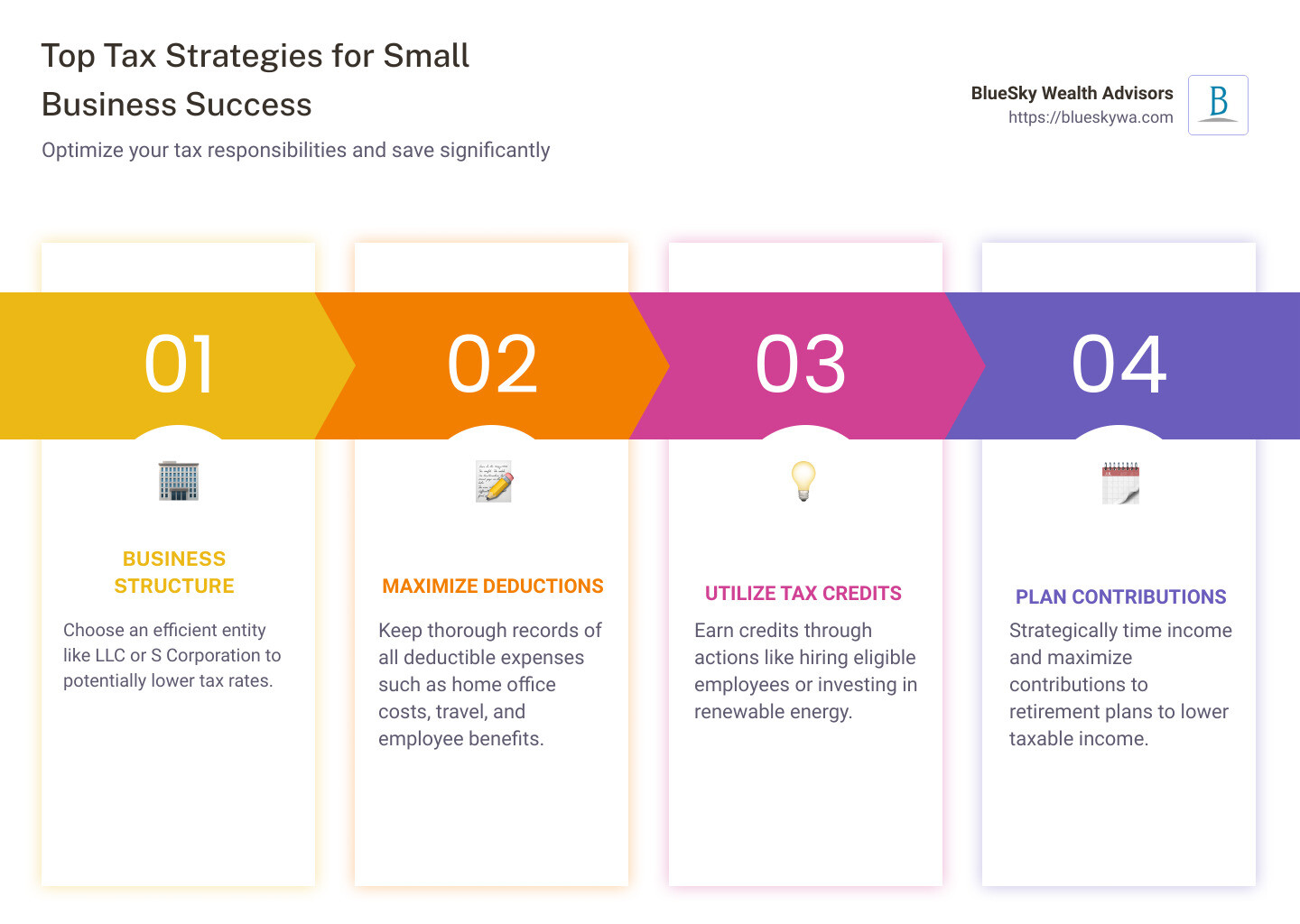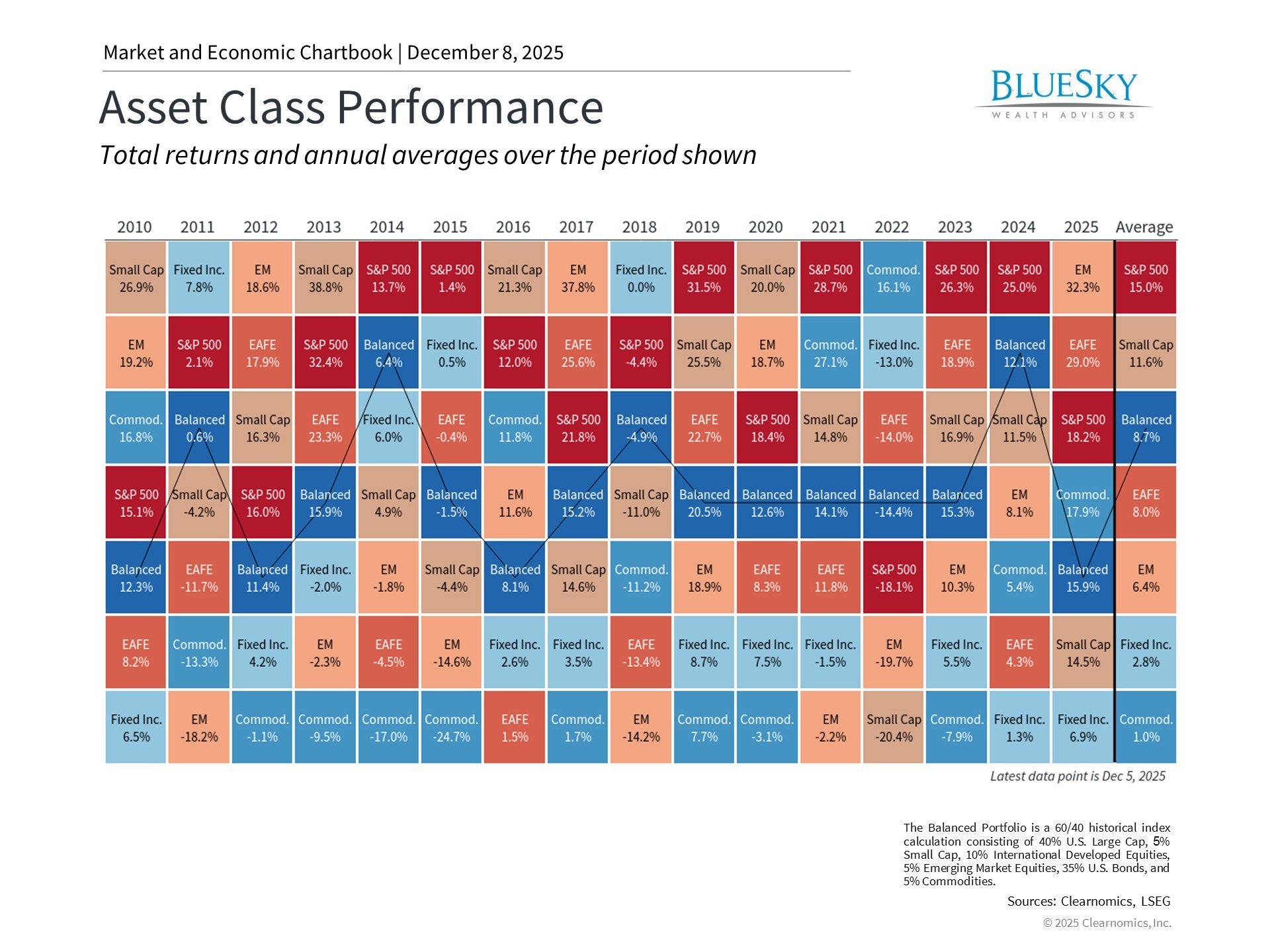
Top 5 Tax Reduction Strategies for Small Business in 2024
Top 5 Tax Reduction Strategies for Small Business in 2024

Introduction
If you’re a small business owner looking to navigate through tax season efficiently, understanding and implementing tax reduction strategies for small business is crucial. These strategies not only ensure compliance and save money but also set a robust foundation for future financial success. Below is a brief overview for quick insight:
- Structure Your Business Effectively: Opt for a business entity like LLC or S Corporation to potentially lower tax rates.
- Maximize Deductions: Keep track of all deductible expenses such as home office costs, travel, and employee benefits.
- Utilize Tax Credits: Engage in activities that earn credits like hiring eligible employees or investing in green energy.
- Plan Contributions and Income: Choose the right timing for income and make maximum contributions to retirement plans.
Tax planning is essential in maintaining a healthy financial status and capitalizing on available benefits. It’s about much more than meeting legal requirements; it’s a strategic approach that significantly reduces liabilities and assists in business growth. Through careful planning and utilization of deductions and credits, you can significantly decrease your taxable income and increase your business’s net profit.
In this guide by BlueSky Wealth Advisors, we’ll uncover practical strategies and administrative actions you can integrate into your business operations to not just meet but capitalize on your fiscal responsibilities.

Understanding Tax Reduction Strategies for Small Business
Navigating taxes can be complex, especially for small business owners looking to maximize their financial outcomes. Effective tax management involves more than just fulfilling annual obligations; it’s about strategically harnessing deductions, credits, and deferrals to reduce tax liability. Let’s break down these key components to simplify how they can benefit your business.
Deductions: The Essentials
Deductions are expenses that the IRS allows you to subtract from your total income, effectively reducing the income on which you are taxed. For small businesses, common deductions include:
- Home Office: If you use a part of your home regularly and exclusively for business, you may deduct expenses like rent, utilities, and repairs proportionate to the space used.
- Equipment and Supplies: Purchases such as computers, software, and office supplies are typically deductible in the year they are purchased.
- Vehicle Expenses: If you use your vehicle for business, costs like gas, repairs, and depreciation can be deducted based on the percentage of business use.

Credits: Direct Tax Savings
Unlike deductions, which reduce the income subject to tax, credits directly reduce your tax bill. Here are a few impactful ones:
- R&D Tax Credit: For businesses involved in research and development, this credit can offset some of the costs associated with innovative projects.
- Work Opportunity Tax Credit (WOTC): This is available if you hire individuals from certain groups who face significant barriers to employment.
- Clean Energy Credits: If your business invests in renewable energy sources, you may be eligible for credits that reduce your tax liability.
Deferrals: Timing Is Key
Deferring income to the next tax year can be a strategic choice for businesses expecting a higher tax rate in the current year. This can be achieved through:
- Delayed Invoicing: If you have control over when you receive income, consider delaying invoices to push income into the next fiscal year.
- Retirement Plans: Contributions to retirement plans like a 401(k) can defer taxes until the money is withdrawn in retirement, typically at a lower tax rate.
Practical Application
Let’s consider a case where a small business owner invests in new computers and office furniture. By understanding and applying the Section 179 deduction, they can deduct the full purchase price of these items from their gross income. This upfront deduction provides immediate tax relief, reducing the year’s taxable income and thus the tax liability.
Strategic Insight
A smart move for small business owners is to schedule a year-end review of their financials. This review can help identify opportunities for last-minute deductions or whether deferring income could be beneficial given their current year’s profits and anticipated next year’s earnings.
By integrating these tax reduction strategies into your financial planning, you can not only comply with tax laws but also enhance your business’s financial health. Each business is unique, so consider consulting with a tax professional to tailor these strategies to your specific circumstances. This proactive approach, detailed in our guide by BlueSky Wealth Advisors, empowers you to make informed decisions that align with both your immediate financial needs and long-term business goals.
Key Tax Deductions Every Small Business Should Consider
When it comes to tax reduction strategies for small business, understanding key deductions is essential. These deductions can significantly lower your taxable income and reduce your overall tax burden. Let’s dive into three critical areas: Home Office, Equipment, and Vehicle Expenses.
Home Office Deduction
Many small business owners operate out of their homes, but not everyone takes advantage of the home office deduction. To qualify:
- Regular and Exclusive Use: The space must be regularly used exclusively for business.
- Principal Place of Business: This area must be where you conduct your primary business activities, like managing and billing.
If you meet these conditions, you can choose between two calculation methods:
– Simplified Option: Multiply the square footage of your office (up to 300 square feet) by $5.
– Regular Method: Calculate the percentage of your home used for business and apply it to home expenses like mortgage interest or rent, utilities, and insurance.
This deduction not only simplifies your tax filing but can also significantly decrease your tax liability.
Equipment Deductions
Investing in business equipment can lead to substantial tax savings. Under Section 179, you can immediately deduct the cost of qualifying equipment—such as computers, furniture, and machinery—rather than depreciating it over several years. For 2023, the limit is $1,080,000. This upfront deduction can reduce your taxable income substantially in the year of purchase.
Vehicle Expenses
For small businesses that use vehicles, there are two methods to calculate deductible expenses:
– Standard Mileage Rate: For 2023, it’s 65.5 cents per mile. This rate covers not just gas but also depreciation, insurance, and other costs.
– Actual Expenses: Track all costs associated with your business vehicle—gas, repairs, insurance, depreciation—and deduct a portion based on the percentage of business use.
Additionally, if your vehicle weighs more than 6,000 pounds, you might qualify for a larger deduction under the same Section 179 mentioned above.
By carefully documenting these expenses and understanding how to apply them, you can turn necessary business costs into valuable tax deductions.
By incorporating these deductions into your tax strategy, you can significantly reduce your tax obligations, directing funds back into growing and sustaining your business. As always, it’s wise to consult with a tax professional to ensure you’re maximizing these opportunities tailored to your specific business activities. Next, we’ll explore how maximizing tax credits can further reduce your small business tax liability.
Maximizing Tax Credits to Reduce Small Business Liability
Tax credits are a powerful tool for small businesses looking to reduce their tax bills. Unlike deductions, which lower the amount of income subject to tax, credits directly decrease your tax liability, dollar for dollar. Let’s delve into three significant tax credits that could save your small business a substantial amount of money: the Research and Development (R&D) Credit, the Work Opportunity Tax Credit (WOTC), and Clean Energy Credits.
Research and Development (R&D) Credit
If your business invests in innovation, whether developing new products or improving existing ones, you may be eligible for the R&D Credit. This credit is designed to encourage businesses to keep pushing the boundaries of what’s possible, which in turn helps grow the economy.
- Who qualifies? Businesses of any size that perform eligible research activities.
- What’s the benefit? The credit amount varies based on the expenses related to eligible R&D activities.
A practical example is a tech startup developing a new software tool. By claiming the R&D Credit, they could offset some of the costs associated with their research, making their innovative project more financially feasible.
Work Opportunity Tax Credit (WOTC)
The WOTC is aimed at promoting the hiring of individuals who face significant barriers to employment. This includes veterans, ex-felons, and individuals receiving certain types of public assistance.
- Who qualifies? Employers who hire from designated groups facing employment barriers.
- What’s the benefit? The credit can be up to $2,400 per eligible employee, depending on the target group and the wages paid.
For instance, a small cafe that hires a veteran could benefit from the WOTC, reducing its tax liability while supporting a valuable community member’s reintegration into the workforce.
Clean Energy Credits
With a growing focus on sustainability, Clean Energy Credits are particularly appealing. These credits are available for businesses that invest in renewable energy sources like solar panels, wind turbines, or geothermal systems.
- Who qualifies? Businesses that install or invest in renewable energy systems.
- What’s the benefit? The credit typically covers a percentage of the cost of purchasing and installing renewable energy systems.
An example here could be a small manufacturing firm that installs solar panels on its facility’s roof. Not only would the business reduce its energy costs over time, but it could also claim a tax credit for a portion of the installation cost, reducing its tax burden.
Utilizing these tax credits can significantly reduce your small business’s tax liability. Each credit has specific eligibility criteria and benefits, so it’s crucial to understand which credits your business can claim. Implementing these tax reduction strategies for small business not only supports your financial health but also encourages practices that benefit the broader community and environment.
Next, we’ll consider how strategic tax planning with retirement solutions can further optimize your tax situation and support your long-term business goals.
Strategic Tax Planning with Retirement Solutions
When it comes to tax reduction strategies for small business, incorporating retirement solutions is a powerful approach. Not only do these plans offer tax benefits, but they also help in securing the financial future of both the business owners and their employees. Here’s a breakdown of some key options:
SEP IRA (Simplified Employee Pension Plan)
A SEP IRA is ideal for self-employed individuals or small business owners with few or no employees. Here’s why:
– High Contribution Limits: You can contribute up to 25% of each employee’s pay (including your own), with a maximum of $66,000 for 2023.
– Flexibility in Contributions: Contributions aren’t mandatory every year. In years when business is good, you can contribute more, and in lean years, less or none at all.
– Simple to Set Up and Maintain: There are no significant administration costs, making it cost-effective for small businesses.
SIMPLE IRA (Savings Incentive Match Plan for Employees)
For businesses with 100 or fewer employees, a SIMPLE IRA is an excellent choice:
– Dual Contribution Options: Employers can either match employee contributions dollar for dollar up to 3% of their salary or contribute 2% of each employee’s salary regardless of the employee’s contributions.
– Immediate Vesting: Benefits are immediately 100% vested, which can be a strong incentive for employee retention.
– Contribution Limits: The contribution limit for 2023 is $15,500, or $19,000 if the employee is age 50 or older.
401(k) Plans
A 401(k) is one of the most popular retirement options available:
– Higher Contribution Limits: For 2023, employees can contribute up to $22,500, with an additional $7,500 catch-up contribution for those aged 50 and above.
– Employer Matching: Encourages greater employee participation in the plan.
– Tax Deferral: Contributions are made pre-tax, reducing taxable income for the year they are made.
Profit-Sharing Plans
Profit-sharing plans are a flexible way to provide retirement benefits:
– Discretionary Contributions: Employers can decide from year to year how much to contribute, or whether to contribute at all, depending on the business profits.
– Motivation and Loyalty: Helps align the interests of employees with those of the business, as their benefits depend on the company’s profitability.
Case Study: Consider the example of a small tech startup that implemented a SEP IRA. The owner was able to contribute 25% of his income to the plan, which not only reduced his taxable income but also allowed him to save significantly for retirement. This move was mirrored for his employees, enhancing their job satisfaction and loyalty to the company.
Implementing these retirement solutions requires careful planning and understanding of the tax implications. Each plan has its nuances and tax benefits, so it’s crucial to choose the one that aligns best with your business structure and goals. Partnering with a financial advisor like BlueSky Wealth Advisors can provide tailored advice that maximizes these benefits while ensuring compliance with all tax laws.
By integrating retirement planning into your strategic tax planning, you not only foster a secure financial future but also leverage significant tax advantages that can improve your business’s bottom line.
Next, we’ll explore more innovative tax reduction strategies for small business to further enhance your savings and operational efficiency.
Innovative Tax Reduction Strategies for Small Business
Hiring Family Members
One effective way to reduce the tax burden for small businesses is by hiring family members. This strategy not only supports your family financially but also offers significant tax benefits. When you employ your children or spouse, you’re able to shift income to them, potentially placing it in a lower tax bracket, which can reduce your overall tax liability.
Tax Benefits:
– Income Shifting: By paying family members, you transfer income to their lower tax brackets.
– Social Security and Medicare Taxes: Wages paid to your children under 18 are exempt from these taxes, which can represent substantial savings.
– FUTA Taxes: Hiring your spouse may exempt you from Federal Unemployment Tax Act contributions, depending on your business structure.
It’s crucial that the work they do is legitimate and the pay they receive is reasonable for their duties. This not only complies with IRS requirements but also ensures the integrity of your business practices.
Choosing the Right Business Structure
Selecting the optimal structure for your business can significantly impact your tax obligations and personal liability. Here are three common structures and their tax implications:
- LLC (Limited Liability Company): This structure provides liability protection while allowing profits to pass through to your personal tax return, helping avoid double taxation.
- S Corporation: Ideal for small businesses that meet the IRS requirements, allowing owners to draw salaries and receive dividends, which can be taxed at a lower rate than income.
- C Corporation: Offers the benefit of being taxed separately from its owners, potentially at a lower rate since the corporate tax rate was reduced to 21% under the Tax Cuts and Jobs Act.
Each structure has its unique benefits and drawbacks, and the choice depends heavily on your specific business needs and financial goals.
Leveraging Health Plans for Tax Savings
Health Savings Accounts (HSAs) and health insurance deductions are powerful tools for reducing taxable income. Implementing HSAs for employees not only helps in tax savings but also aids in managing future health costs more effectively.
Key Points:
– HSAs: Contributions are made pre-tax, reducing taxable income. Funds grow tax-free and can be withdrawn tax-free for qualified medical expenses.
– Health Insurance Deductions: Premiums paid for employee health insurance can often be deducted, lowering the overall taxable income.
These strategies are not just about savings; they also contribute to the health and wellness of your team, which can improve overall productivity and job satisfaction.
By employing these innovative tax reduction strategies, small businesses can leverage significant savings while ensuring compliance and supporting their employees and families. As always, it’s advisable to consult with a tax professional or a financial advisor like BlueSky Wealth Advisors to tailor these strategies to your specific business circumstances and maximize your benefits. Next, we’ll delve into proactive tax planning with BlueSky Wealth Advisors to optimize these strategies over the long term.
Proactive Tax Planning with BlueSky Wealth Advisors
Effective tax planning is not just about reacting to the tax season; it’s about being proactive throughout the year. BlueSky Wealth Advisors excels in helping small business owners implement strategies that not only reduce taxes in the short term but also maximize financial efficiency over the long haul. Let’s explore how personalized strategies and multi-year planning can benefit your business.
Personalized Strategies
No two businesses are the same, which is why cookie-cutter advice simply doesn’t work when it comes to tax planning. BlueSky Wealth Advisors understands this. They start by getting a deep understanding of your business model, financial situation, and future goals.
For instance, if your business has a significant amount of equipment purchases, BlueSky might suggest more aggressive depreciation tactics. Or, if you’re planning to expand, they might recommend deferring certain types of income to align better with your growth phases. This tailored approach ensures that every strategy directly contributes to reducing your tax liabilities effectively.
Multi-Year Planning
Tax planning should not be viewed as a one-time activity but rather as a continuous strategy that evolves. BlueSky Wealth Advisors helps you plan not just for the current year, but for many years ahead. This might include setting up retirement plans that benefit you and your employees in the long term, or making business structure changes that provide sustained tax advantages.
By considering future tax implications of current decisions, BlueSky helps you avoid the pitfalls that could lead to higher taxes down the road. For example, they can guide you on how much income to defer and the best times to take specific deductions based on projected changes in tax laws.
In summary, proactive tax planning with BlueSky Wealth Advisors revolves around understanding your unique business needs and planning strategically for the future. This approach not only helps in significantly reducing your current tax burden but also sets up a strong foundation for financial growth and stability.
Leveraging these personalized and forward-thinking strategies will ensure that your business is not only prepared for the upcoming tax season but is also positioned well for future financial challenges and opportunities. Next, we will discuss how continuous engagement with BlueSky Wealth Advisors can keep your business at the forefront of tax efficiency and compliance.
Conclusion
Long-Term Benefits
When we adopt tax reduction strategies for small business, the benefits extend far beyond the immediate savings on your next tax bill. Strategically managing your taxes means more than just meeting legal requirements—it’s about enhancing the financial health and potential of your business over the long haul.
By optimizing your tax situation, you’re effectively increasing the capital available to reinvest in your business—be it through expanding operations, enhancing employee benefits, or investing in new technology. This reinvestment not only drives your business forward but also strengthens its competitive edge in the market.
Moreover, the money saved through effective tax planning can act as a financial buffer, providing security against economic downturns and allowing for strategic flexibility in decision-making. This is crucial for maintaining business continuity and supporting sustainable growth.
Continuous Learning
Tax laws are constantly evolving, and staying informed is crucial. At BlueSky Wealth Advisors, we emphasize the importance of continuous learning as a core component of effective tax management. By keeping abreast of the latest tax changes and strategies, you can make informed decisions that align with both current laws and your business goals.
We encourage regular consultations and provide resources that help demystify complex tax issues. This proactive approach ensures that you’re always leveraging the most current and beneficial strategies available.
To truly benefit from tax reduction strategies for small business, view tax planning as a dynamic and ongoing part of your business strategy. Partnering with experts like us at BlueSky Wealth Advisors ensures that your tax planning adapts to new laws, your evolving business needs, and the shifting economic landscape.
In conclusion, integrating these tax strategies effectively requires a commitment to long-term planning and education. By focusing on these areas, your business can enjoy sustained growth and financial health, well-prepared for future challenges and opportunities in the ever-changing world of tax policy.





